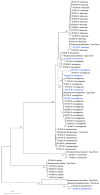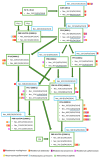Culturable Yeast Diversity Associated with Industrial Cultures of the Microalga Microchloropsis gaditana and Their Ability to Produce Lipids and Biosurfactants
- PMID: 40137265
- PMCID: PMC11943003
- DOI: 10.3390/jof11030228
Culturable Yeast Diversity Associated with Industrial Cultures of the Microalga Microchloropsis gaditana and Their Ability to Produce Lipids and Biosurfactants
Abstract
The marine oleaginous microalga Microchloropsis gaditana (formerly Nannochloropsis gaditana) exhibits a high capacity to thrive in a broad range of environmental conditions, being predominantly utilized as feed in aquaculture. This article reports the characterization of the culturable yeast population present during the scale-up process of M. gaditana cultivation at Necton S.A. facilities, from 5 L flasks until tubular photobioreactors. The 146 yeast isolates obtained, molecularly identified based on D1/D2 and ITS nucleotide sequences, belong to the species Rhodotorula diobovata, R. mucilaginosa, R. taiwanensis, R. sphaerocarpa, Vishniacozyma carnescens, Moesziomyces aphidis, and Meyerozyma guilliermondii. The yeast abundance was found to increase throughout upscaling stages. The yeast populations isolated from microalgal cultures and water samples share phylogenetically close isolates, indicating a possible common source. The impressive high percentage of red yeasts isolated (90%) is consistent with the recognized role of carotenoid pigments in yeast photoprotection. Sixty yeast isolates were tested for lipid (Nile Red staining) and biosurfactant (oil drop dispersion and emulsification index) production. Results revealed that these capacities are common features. Microbial lipids and biosurfactants have promising biotechnological applications. Moreover, biosurfactants can fulfill various physiological roles and provide advantages in natural environments contributing to the promising use of yeasts as probiotics in microalgae production.
Keywords: Basidiomycota; Rhodotorula; biotechnological applications; microalgae cultivation; yeast isolation; yeasts.
Conflict of interest statement
Authors Inês Costa and Natacha Coelho are employed by the Necton S.A. The remaining authors declare that the research was conducted in the absence of any commercial or financial relationships that could be construed as a potential conflict of interest.
Figures




Similar articles
-
Astaxanthin and eicosapentaenoic acid production by S4, a new mutant strain of Nannochloropsis gaditana.Microb Cell Fact. 2022 Jun 16;21(1):117. doi: 10.1186/s12934-022-01847-9. Microb Cell Fact. 2022. PMID: 35710482 Free PMC article.
-
Isolation, molecular identification of lipid-producing Rhodotorula diobovata: optimization of lipid accumulation for biodiesel production.J Genet Eng Biotechnol. 2022 Feb 21;20(1):32. doi: 10.1186/s43141-022-00304-9. J Genet Eng Biotechnol. 2022. PMID: 35190920 Free PMC article.
-
Genome Sequence Analysis of the Oleaginous Yeast, Rhodotorula diobovata, and Comparison of the Carotenogenic and Oleaginous Pathway Genes and Gene Products with Other Oleaginous Yeasts.J Fungi (Basel). 2021 Apr 20;7(4):320. doi: 10.3390/jof7040320. J Fungi (Basel). 2021. PMID: 33924147 Free PMC article.
-
Carotenoid Production in Oleaginous Yeasts.Adv Exp Med Biol. 2021;1261:153-163. doi: 10.1007/978-981-15-7360-6_12. Adv Exp Med Biol. 2021. PMID: 33783737 Review.
-
The history, state of the art and future prospects for oleaginous yeast research.Microb Cell Fact. 2021 Dec 7;20(1):221. doi: 10.1186/s12934-021-01712-1. Microb Cell Fact. 2021. PMID: 34876155 Free PMC article. Review.
References
-
- Osorio-Reyes J.G., Valenzuela-Amaro H.M., Pizaña-Aranda J.J.P., Ramírez-Gamboa D., Meléndez-Sánchez E.R., López-Arellanes M.E., Castañeda-Antonio M.D., Coronado-Apodaca K.G., Gomes Araújo R., Sosa-Hernández J.E., et al. Microalgae-Based Biotechnology as Alternative Biofertilizers for Soil Enhancement and Carbon Footprint Reduction: Advantages and Implications. Mar. Drugs. 2023;21:93. doi: 10.3390/md21020093. - DOI - PMC - PubMed
-
- Kofi Tulashie I.S., Iddrisu M., Miyittah M., Atiiga A.-W., Mensah S., Dadzie A. Large scale production of lipid for biodiesel from green microalgae using wastewater. Chem. Eng. Commun. 2023;210:2146–2160. doi: 10.1080/00986445.2023.2185520. - DOI
-
- Narala R.R., Garg S., Sharma K.K., Thomas-Hall S.R., Deme M., Li Y., Schenk P.M. Comparison of Microalgae Cultivation in Photobioreactor, Open Raceway Pond, and a Two-Stage Hybrid System. Front. Energy Res. 2016;4:29. doi: 10.3389/fenrg.2016.00029. - DOI
Grants and funding
- C644915664-00000026/Next Generation EU European Fund and the Portuguese Recovery and Resilience Plan (PRR)
- UIDB/04565/2020/Fundação para a Ciência e a Tecnologia
- UIDP/04565/2020/Fundação para a Ciência e a Tecnologia (FCT)
- LA/P/0140/2020/Fundação para a Ciência e a Tecnologia (FCT)
- UIDB/04326/2020/Fundação para a Ciência e a Tecnologia (FCT)
LinkOut - more resources
Full Text Sources

